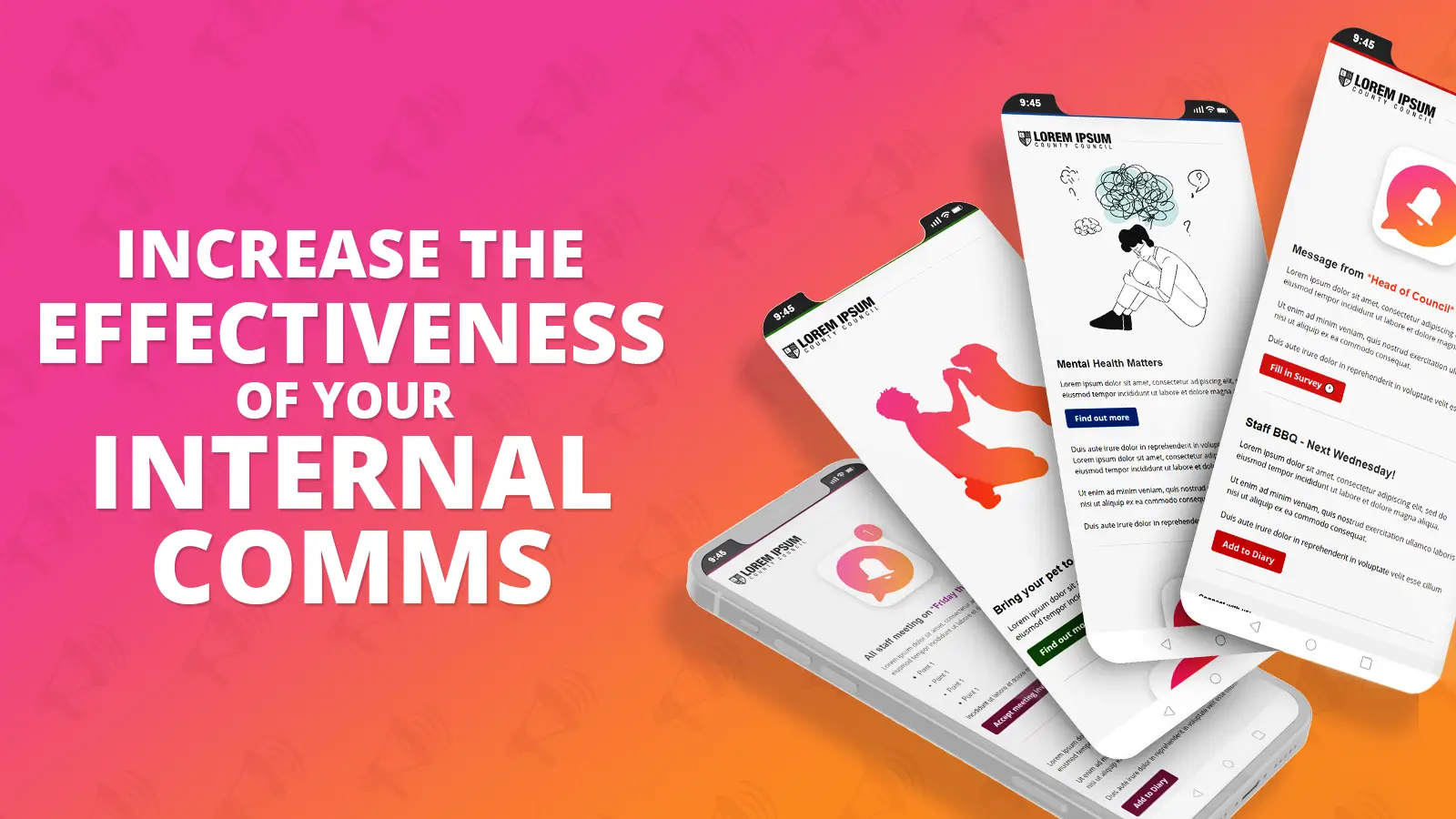Blog
CATEGORY: Increase the effectiveness of internal comms
Increase the effectiveness of internal comms

In the words of LGA “Delivered correctly, internal communications have the ability to inform, engage and inspire your workforce to fulfil your ambitions and overcome your challenges.”
The heart and success of any organisation lies with it’s people.
Russell Grossman, Government Communication Service Head of Profession for Internal Communications defines it as a function that exists: ‘to help leaders […] inform and engage employees, in a way which motivates staff to maximise their performance and deliver the business strategy most effectively.”
The 2012 Engage for Success Research by David MacLeod and Nita Clarke identified that there were four common themes that could make employee engagement more successful – all of which include an element of internal communication:
strategic narrative – visible and communicative leaders that tell a compelling story about where the organisation is headed
engaging managers – who support their teams and give individuals the freedom to succeed
employee voice – employees who feel free to speak up, have many different kinds of opportunities to have their say and are listened to by their managers
integrity – the values on the wall are reflected in day to day behaviours. There is no ‘say –do’ gap. Promises made and promises kept, or an explanation given as to why not.
Internal communications is undoubtedly a key part of this but it is important to remember that internal communication is an action – a function that uses information and dialogue to inform, motivate and inspire. Employee engagement is a reaction – the outcome you get as a result of investing time, money and strategy into communicating with your people and making your organisation a great place to work.
It’s also important to remember that there are issues beyond communication that contribute to employees’ general satisfaction and engagement with their work. These include issues such as training and development opportunities, cultural and environmental factors, pay and benefits, recruitment and retention matters and management structures among others. These things can’t be addressed by internal communication alone.
It is for this reason that some councils and other organisations make broad employee engagement work part of HR, while internal communications sits as part of a wider communication directorate.
Why does internal communication matter?
At its simplest level, internal communication matters because it enables your employees to do their jobs more effectively, which in turn means you can deliver the best possible service to your residents, partners and stakeholders. Internal communications helps to explain what is expected of your employees so they can help fulfil the ambitions set out in your corporate plan.
But there are also other benefits. Internal communications can have a positive impact on performance, retention, innovation, customer satisfaction and wellbeing – putting your organisation in the best possible position to achieve your strategy.
Employees are a key component of your brand and what you offer customers – whether they’re dealing face to face, on email, or over the phone.
The overall success of your organisation’s business strategy depends on employees translating your brand values into appropriate behaviour on the ground. The critical points of contact between a customer and your organisation – telephone conversations, email exchanges and face-to-face engagement – are sometimes referred to as ‘moments of truth’. At each point of contact your brand promise is tested.
If employees understand your vision and values, and how they can put them into practice in their day-to-day jobs, then you are much more likely to achieve your business strategy.
Developing your internal communications strategy
A dedicated internal communications strategy is a helpful way of ensuring that your activities remain focused on the issues that matter most to your staff and your organisation as a whole.
If employees know what needs to be done, and what their role is in achieving this, they can align their efforts to the strategy. It’s not enough just to tell employees what the strategy is; you have to equip them to deliver it through good internal communication and engagement.
As with any strategy development understanding where we are now, and where we want to be are the first steps to building the plan of "how we are going to get there"
The LGA has put together their Top10 tips for better internal communications are a great place to start, underpinning your strategy.
Understand your organisation
Get to know your people
Build strong, collaborative relationships
Define your strategy
Create and seek out great content
Do your research
Evaluate and seek feedback
Advise and challenge
Seek out support
Have fun!
All too easily overlooked, number 10 is key.
One of the best aspects of internal communications is that you get the chance to celebrate the work of your staff as people, not just employees. Look for opportunities to communicate some lighter aspects of work, from cake sales, fun runs and social events and encourage colleagues to also have fun with their communications. The more enthusiastic you are about making internal communication enjoyable as well as informative, the better your chance of engaging and influencing your colleagues.
Build a strategic partnership with HR
As natural allies, internal communications and HR should assess the communication processes that tie their organisations together. This will help share data and avoid duplication of effort.
Your internal communications strategy must support your people strategy. It must share key performance indicators, around engagement for example, so you are all working in the same direction.
HR needs to be involved because internal communications is not just about distributing information – it’s about creating understanding and engagement.
Change is a constant for all organisations, with organisations needing to be more agile and innovative to succeed. This makes it even more important for employees to have trust in their leaders, and confidence they can deliver and manage the change.
But almost universally levels of trust in leaders/leadership have decreased, coupled with a 'modern cynicism'. People no longer have the confidence in authority, just by nature of it being authority. People are just fundamentally less trusting now than they were, say, 50 years ago. The shift from ‘deference to reference’ has been accelerated by the rapid growth of the internet and increasing popularity of social networking and alternative sources of news, away from the mainstream media.
This change has spread its way into the workplace, and poses new challenges for senior leaders and internal communicators when trying to shape an authentic narrative and build trust. Research shows only 51% of employees have trust and confidence in the senior leadership of their companies and only 44% believe senior leaders are trying to do their best for their employees.
Prepare for the future
It’s clear the environment for internal communicators, and the skills they need, are changing rapidly. Summarised elegantly here by Kevin Ruck, Co-founder PRAcademy and Editor of “Exploring Internal Communication”
“Smart internal communication practitioners will finally realise that they hold the key to unlocking higher levels of employee engagement by facilitating employee voice. The era of internal information transmission is coming to an end. Craft communication skills are less important. Polished prose is perceived as propaganda.
Organisations that embrace the potential of giving employees a voice will see their culture energised with increased innovation, generating ideas that improve performance. Ambitious practitioners will grab the opportunity to be at the centre of new, less deferential, ways of management. They will become expert curators of important knowledge. This will give them more va va voom in their own role and career development.”
Solutions
Email marketing healthcheck
We are confident that we can help you, which is why we offer a free healthcheck to identify potential issues with your current programme and free advice on things that could be done to improve it.
